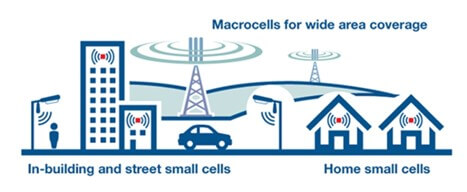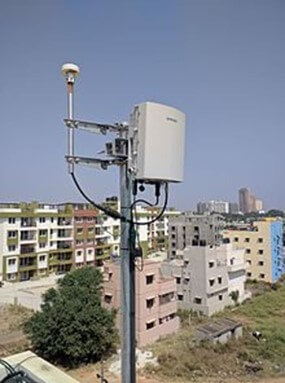Antennas, Antenna Cables, Wireless Products: Technical Articles
Small Cell Cellular Networking Technology
Small Cell Cellular Networking Technology: Key IoT/5g Trend for 2023 and Beyond
A key mid-decade trend for 5G cellular networking is the shift towards the use of small, low power base stations as nodes in the cellular network. These cellular nodes are known as small cells and form a marked shift from the traditional larger cell towers and base stations (known as macrocells) that usually provide cellular coverage over a wide area.
Though small cell technology is not novel, it is becoming more prominent in cellular network infrastructure and is increasingly consumer-facing and adapted for a wide range of novel networking applications. It will provide the network operators not only with the ability to provide low-latency connectivity across networks, but also meet the burgeoning demand of IoT applications. There is therefore a rush to increase the density of current network provision with these smaller new radio devices. Small cell technology is also a means by which 5G cellular networking is likely to become increasingly decentralized, with peer-to-peer networking models becoming prominent.
This digest will look at what small cells are, the demand for small cell cellular networking, key applications, and antenna requirements for small cells.

What are small cells?
Small cell is a key term used to describe a class of physically compact, low-power radio communications equipment that is capable of operating as a base station. Like conventional macrocells, small cells can deliver millimeter-wave transmission with MIMO and beamforming technologies delivered on a smaller scale.
These radio access nodes are used to provide cellular phone and mobile internet coverage within their immediate area. They can be used with licensed or unlicensed portions of the radio spectrum and vary in the distance covered which is usually no more than a few hundred meters when compared to a standard macrocell.
The service provision of a small cell is highly localized. This means that they are used to provide focused areas of coverage, for example within a building or contained outdoor areas. Multiple small cells can be used to better distribute coverage within a cellular network, increasing its capacity and quality of connections in a specific area. Small cells do require backhaul, which may be wired, wireless, or fiber, as well as power connections that will determine their placement and add expense to an installation.
How do small cells differ from cellular boosters?
Cellular boosters and small cells are not the same, though both may be used to enhance cellular coverage in a specific area. Cellular boosters are cellular signal repeaters that consist of a donor antenna, amplifier, and indoor antenna that rebroadcasts a cellular signal that is acquired and amplified from outside. Small cells are miniaturized base stations that generate their cellular footprint rather than rebroadcasting an existing signal.
Types of small cells
There are many types of small cells. Small cells are typically classified by size, capacity, and application. They can also be classified according to their volume and level of transmitted power. For example, a medium-range small cell has a volume of between 5 and 15 liters and is capable of a transmit power of up to 12W. Here are some of the key types of commercially available small cells:
- What is a femtocell? Femtocells are the smallest small cells (palm-sized) available and provide hyper-target cellular connectivity in a small area with wireless backhaul . Their typical coverage is between 32 and 164 feet (10 to 50 meters). They also consume less power (110 milliwatts) and bandwidth than other small cells and are used as low impact, low footprint solutions that can supplement coverage where there is existing network backhaul. Consumer femtocells can be used in the home to provide full cellular coverage for phone calls. They can also be used in small offices to provide broadband cellular coverage staff and will typically cover between 8 and 16 users. Femtocells will use existing bandwidth to provide their coverage so the quality of broadband connectivity will diminish if a phone call is made.
- What are picocells? Picocells are slightly larger base stations than femtocells, approximately the size of an A4 ream of paper. They provide a larger area of coverage than femtocells (up to 200 meters / 656 feet) and use more power (250 milliwatts) and bandwidth. They are typically installed in buildings, or aircraft to provide coverage or boost network capacity in high traffic areas where the phone and device usage is high. They are advantageous where achieving macrocell coverage is difficult and each picocell can be used by up to 70 devices. Picocells connect to a base station controller (BSC) that will manage the transfer of data between the picocell and the nearest switching center or gateway via a wired or fiber connection. Pico cells are more integrated with macrocells and enhance mobile data capacity where there is existing network coverage.
- What is a microcell? Microcells are another solution for adding capacity to an area with existing cellular coverage and may be used interchangeably with picocells. These miniaturized cell towers are slightly larger than picocells and can achieve coverage of up to 2 kilometers (1.2 miles) with a wired or fiber backhaul. The power (2 to 5 Watts) of the microcell will determine its coverage, which can be used in malls, stations, and stadia. Microcells can be used exclusively to form networks with handover between individual cells. Microcells are more expensive than femtocells and picocells and are typically used in commercial settings.
- What are Metrocells? Metrocells are compact base stations that are distributed in outdoor settings in urban areas to enhance capacity, speed and quality of service for commercial cellular networks. They are installed by cell phone companies and operate primarily in the licensed spectrum. Their smaller size enables metrocells to be mounted unobtrusively on lampposts, bus shelters or advertising boards, and other urban structures. Metrocells are designed to provide a specific level of cover that is specified by the network operator. They are monitored and managed by the operator to ensure that they provide low latency and interference-free coverage of up to 200 meters (328 feet).
Small cells can be used as:
- Home base stations (Home BS): Small cells that are used in the domestic setting.
Local area base stations (Local Area BS): These are enterprise cellular networking solutions that are designed for offices and other commercial environments. They can provide service to the general public that pass through indoor environments like train or bus stations.
- Medium range base stations (Medium Range BS): These base stations provide extended coverage and are networked for use in rural or remote areas like villages. Depending on the design of the base station, these base stations can be rapidly deployed for an emergency or disaster situation.
- In-building systems (IBS): An in-building system is designed to provide cellular coverage in a building.
It is also possible to network small cells as nodes within a distributed antenna system, with each small cell within the system providing an individual low-power area of coverage. The equivalent coverage of all the nodes would match a macrocell without the space and infrastructure required for building a large cell tower. Small cell installations can be mobile as well as stationary, with small cells increasingly used onboard aircraft, shipping, and trains.
Why are small cells important?
Increased end-user demand

Small cells are increasing in prevalence to meet the rapidly increasing demand for mobile connectivity. This is primarily driven by the smartphone which accounts for over 50% of cellular network connections globally. Smartphones are also responsible for increased use of cellular devices indoors (now over 80% of mobile usage) with increased data consumption per device.
As smartphones and laptops are high data consumers they require a quality mobile broadband connection. However higher data rates are only achieved with close proximity to network base station antennas.
A need for robust indoor coverage
Boosting indoor coverage is a conundrum for network operators because the improvements in building insulation and glazing have reduced the penetration of the cellular signal into buildings. The attenuation of the cellular signal has been demonstrated to be greater in newer, better-insulated buildings. Small cells are therefore favored as a solution for enhancing in-building coverage as they can be deployed within buildings for direct provision of the required coverage.
In commercial environments or public buildings, small cells are required to provide the quality of service that the public demands. As indoor mobile usage climbs to over 90% mid-decade, small cells will similarly increase in number and distribution.
A low impact alternative to the macrocell
Small cells also are discrete, meaning that they are likely to be able to be installed in places where a macrocell would not achieve planning permission. Their low footprint means they can be installed in proximity to buildings that are of cultural or historic interest, remaining sympathetic to the surrounding environment. Small cells are advantageous to town and city planners as they are typically mounted at a height no higher than 45 feet, compared to cell towers which can reach 200 feet in height. Planners appear to favor small cell infrastructure as it can blend into the surrounding environment and provides an efficient localized service. This enables cellular network rollouts to proceed with little administrative delay from the local government.
A changing regulatory landscape
As low-power radio access modules, small cells are subject to national and international regulation. At present, the approach to regulating small cells is not globally harmonized because deployments of small cells are largely ad hoc and lacking in a uniform approach. The 5G rollout has brought the issue to the fore as small cells are a key component of 5G cellular networks, enabling them to achieve the network capacity required in particular for IoT connectivity. The 5G network will be heterogeneous or a hetnet , consisting of wide-area coverage provided by macrocells as well as pockets of targeted localized coverage at a small cell level. Regulatory and administrative processes and RF exposure limits for developing new cell sites are currently based on evaluation of the requirements of macrocells rather than small cells which will almost certainly require a review of their registration requirements.
Quick and easy deployment
Small cell hardware is designed for quick and easy deployment with compact hardware that can be readily mounted in discrete, space-limited locations. This means that the rollout of small cells within a particular network can be completed at speed.
Small cell antennas for peer-to-peer and private cellular networks
Small cell radio devices are already being used to provide 3G and 4G/LTE coverage for private cellular networks. The expansion of private cellular networking into the 5G era has opened up the potential for the creation of a peer-to-peer 5G network that uses privately owned small cells as gateways.
The most mature example of this form of open source 5G networking is the partnership between FreedomFi and Wi-Fi HaLow.

Wi-Fi HaLow 5G will provide a national network of privately owned cellular networking gateways operating on the Citizens Broadband Radio Service (CBRS) frequency band. This peer-to-peer network of cellular nodes will be available for IoT application use and offloading of the carrier networks. Private participants in the network can purchase gateway hardware that can be connected to a small cell to provide a portion of the network's cellular coverage. The gateway owner then is paid in a proprietary cryptocurrency for providing network uptime. Wi-Fi HaLow 5G gateways work with suitable CBRS band femtocells, picocells, or microcells . The quality of the small cell and any external cellular antenna that is connected will determine the performance of the gateway and its earning potential.
New antennas for small cells
Antenna selection is key to the performance of a small cell-based cellular networking solution. They affect not only the quality of coverage achieved but also the number of small cells required, as well as the overall deployment cost including ongoing site rental and maintenance. Small cell radios will come equipped with an internal antenna, which is the default antenna and is routinely used for its convenience. However, a more discerning approach to antenna selection could reduce the number of small cell sites substantially.
Network operators and smaller cellular networking providers look for antennas to meet different usage requirements encountered in a 4G or 5G small cell deployment. Antenna solutions for small cells need to be readily procured and simple. The antennas used are typically panel antennas (directional) or omnidirectional antennas.
The antenna designs are selected for minimal visual impact. Discrete designs include cylindrical canisters and Omni-antennas for lighting and shrouded Yagi antennas and panels in malls and stadia.
For network operators, the priority in choosing antennas for small cells aside from meeting the RF capacity and design objectives is the ability to scale small cell installations and drive down cycle time and ongoing costs.
External antennas for small cell networking
The internal antenna of a small cell site is enclosed within the radio device, for a reduced footprint that makes it easier to acquire locations and planning permission for discrete installations on street furniture in areas where the increased capacity is needed. The antenna included with a small cell is undoubtedly lower gain than external antennas and also fixed-tilt which cannot be adjusted. Small cell radios do however provide the means for connection of a compatible external antenna, usually via an SMA connector. An external antenna will have higher gain and also provide variable tilt which means that the antenna can be manually adjusted to concentrate the beam area downwards to improve data throughput in an area with dense usage. Because external antennas can be selected and mounted with more discernment and adjustments where needed, the small cell coverage achieved can cope with higher throughput and data rates with less interference.
As one of the Southwest's leading new small cell antenna distributors, we understand that antenna quality is critical for a small cell deployment.
Your choice of internal or external antenna for your small cell installation can affect your cellular networking deployment in several ways:
- Our quality antennas are built to the highest manufacturing standards and are therefore less likely to be affected by defects and impairments that at best compromise service quality, and at worst can cause network failure and costly downtime. Across a large network with thousands of antennas, even a 1% failure rate can cost hundreds of thousands of dollars in site visits.
- Data Alliance's expansive inventory of cellular antennas provides the consistent performance that end-users and IoT devices need. Durable material and fabrication mean that our outdoor cellular antennas can withstand the challenges of each season while maintaining exemplary performance.
Browse our inventory or contact us directly by phone or email to find out how we can assist you in achieving a successful small cell deployment at any scale.
5G Antennas: Types, Connector Types, Specifications:
Nova Labs ( Helium Miners ) - Frequency Bands and Antenna Connector Types.







